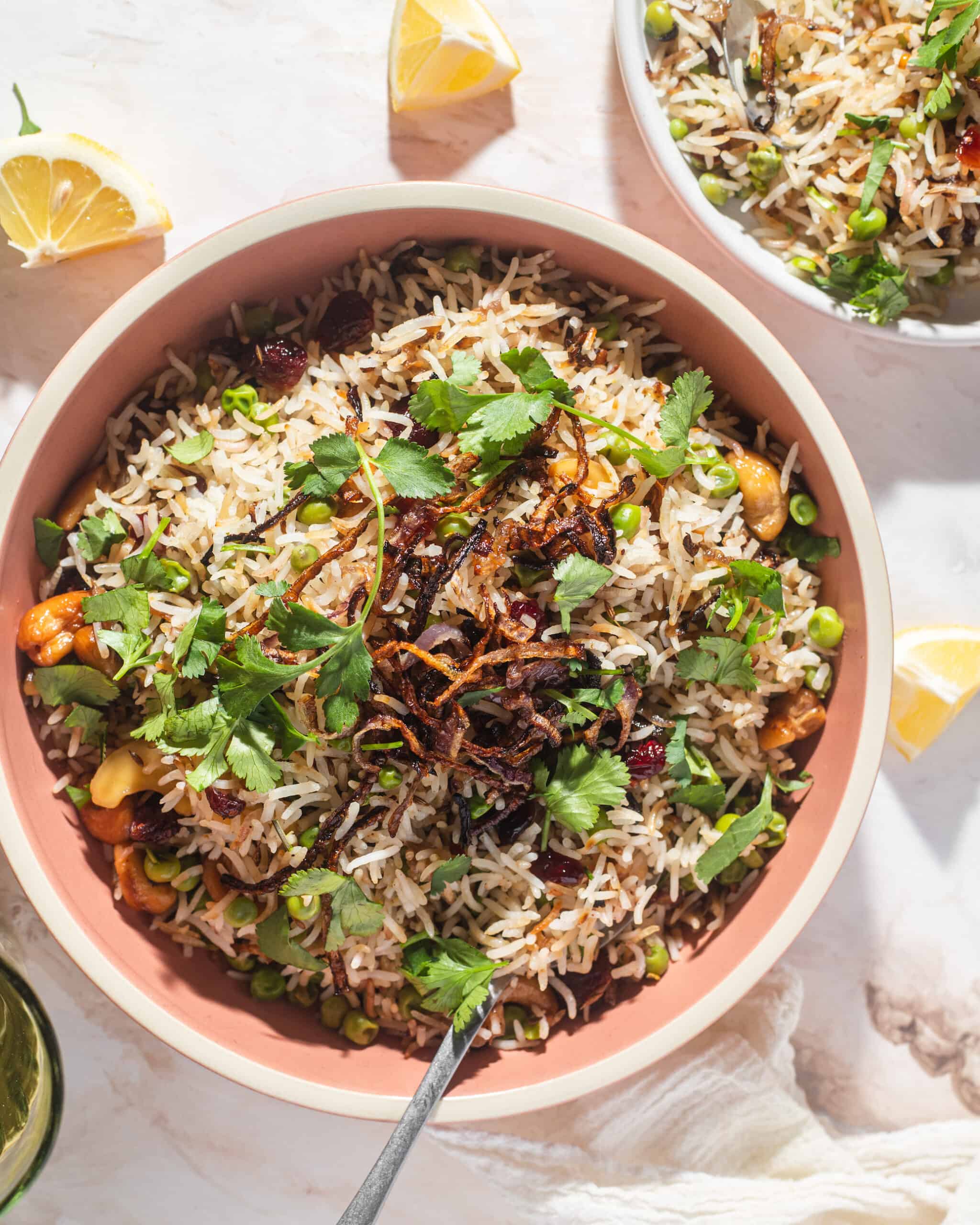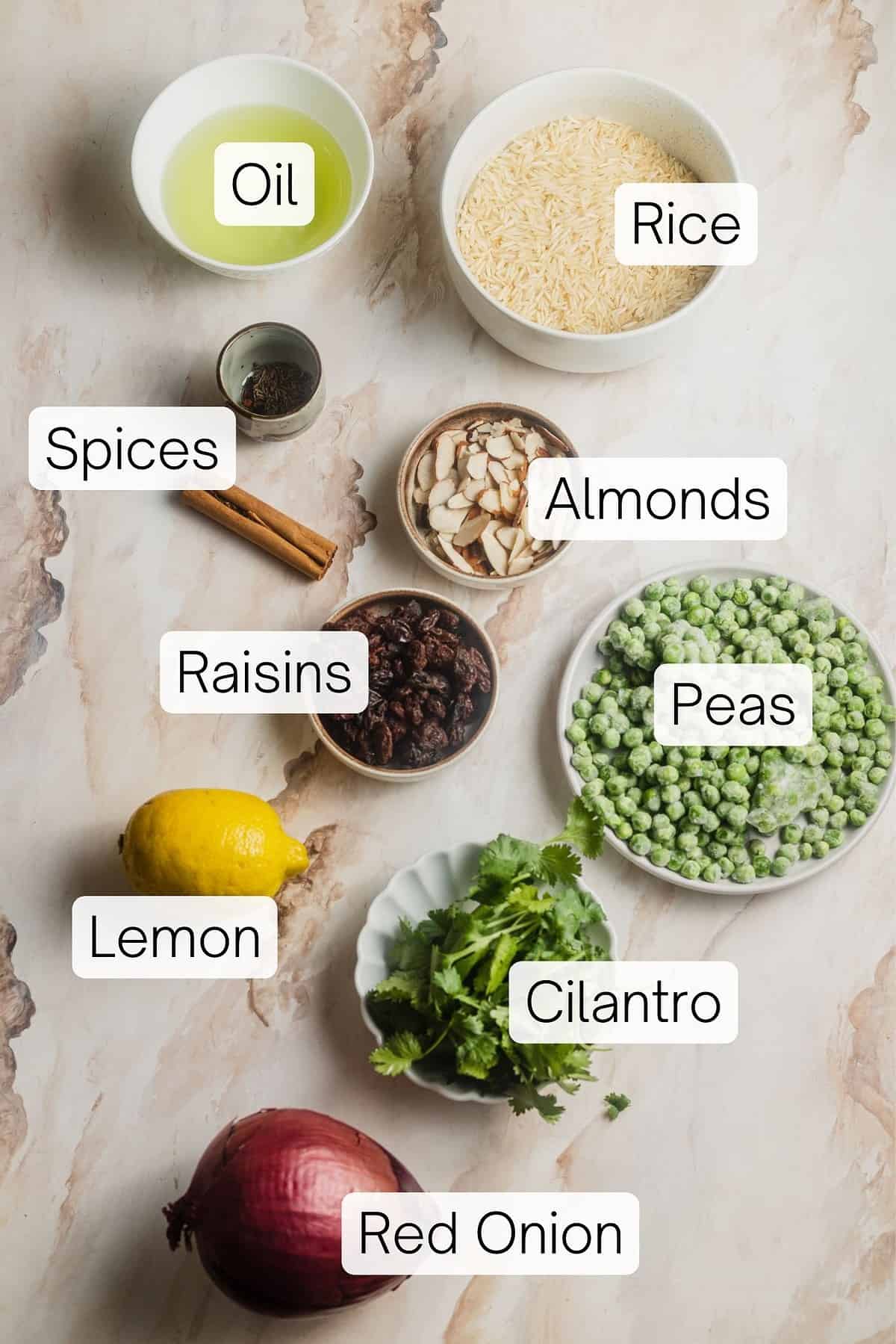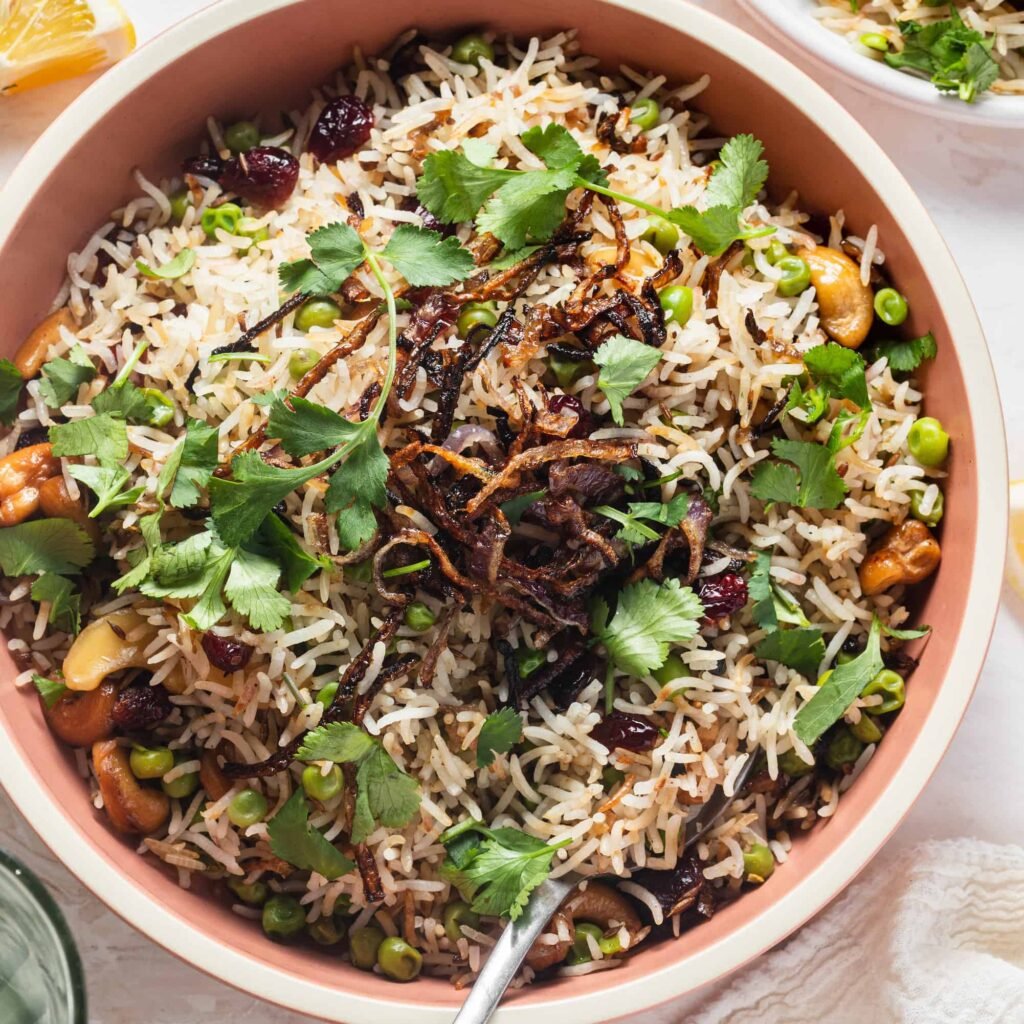This green peas pulao recipe, or matar pulao, uses tried-and-true techniques to produce fluffy, aromatic grains of rice studded with peas and spices. Using the absorption method is a foolproof method for perfectly cooked rice! It makes a wonderful side dish to accompany a main entree like grilled chicken or fish.

Pulao is a bit of a catch-all term for categorizing spiced rice dishes cooked in water or stock. There are vegetable pulaos, like the one I’m showing you here today, meat pulaos, and even seafood pulaos; the possibilities are endless!
This matar pulao (matar meaning 'pea') is made by cooking rice and peas in a fragrant mixture of spices, nuts, and raisins. It's light, bright, and perfect for spring! Looking for more delicious Indian recipes? Try my mushroom biryani, shrikhand recipe, or paneer butter masala.
Why You'll Love This Recipe
Let's talk about what makes this recipe special:
- Flavor: Though it's mildly seasoned with aromatic spices, the pulao is not *spicy*. Fried onions add texture on top, and fresh herbs brighten the whole dish.
- Technique: Pulaos and biryanis can be intimidating! It can be stressful wondering if your rice is going to cook properly. Trust me. I've been there. That's why I recommend parboiling your rice (a technique I learned from Andy Baraghani), which reduces the risk of overcooked or undercooked grains, yielding fluffy, separated pulao.
- Easily Customizable: Once you get the hang of this recipe, you can play with the spices, herbs, and mix-ins! You can replace the peas with chopped asparagus or add ginger-garlic paste for a more fragrant pulao.
What is the Difference Between Pulao and Biryani?
Pulao and biryani are consumed across many countries around the world. Because of the sheer number of variations, it's difficult to qualify the *exact* differences between the two dishes.
That said, there are a few essential differences:
- Pulaos are typically milder in spice1 than biryanis. This is why vegetable pulaos often need to be served with a main entree, whereas biryani can stand alone.
- Traditionally, pulao is made via the absorption method of rice. With the absorption method, the rice grains are cooked in water or stock until fluffy, then finished steaming and cooking at low heat. On the other hand, biryani is often parboiled. I call for parboiling in my recipe because it's more foolproof, but pulao traditionally cooks through absorption.
- Biryanis involves layers of rice and meat/vegetables, while pulaos steam all ingredients together2.
Ingredient Notes

- Extra-Long Basmati Rice: The rice you choose is very important to the resulting texture of the pulao. If you can find it, I recommend aged extra-long basmati rice. Aged basmati is better because it contains less moisture, yielding fluffier, separated grains. An Indian store or online retailers, such as Amazon or Patel Brothers, is your best bet on sourcing the rice.
- Raisins or Cranberries: I've used both raisins and cranberries in this pulao, and they're both delicious! Cranberries add a bit of tang, while raisins add more sweetness.
- Spices: I call for cumin seeds, cinnamon, and cloves, all of which can easily be found in most grocery stores!
- Peas: You can use fresh peas or frozen peas!
Serving Suggestions
The pulao goes really well with a meat entree or vegetarian main dish, and I often serve it with chapatis and raita on the side. It's also delicious with a spoon of chili oil or chili crisp!
How to Make This Recipe

Steps 1 - 4: First, you’ll want to rinse and soak your rice. Make sure to rinse the rice thoroughly, until the water *almost* runs clear (Image 1).
Over medium heat, saute some whole spices in oil (Image 2) and onion gets cooked until soft and translucent (Image 3). This step builds the base of the dish. Stir in the almonds and saute for a minute until they're fragrant (Image 4).

Steps 5 - 6: Next, you’ll parboil the rice until just barely cooked through (Image 5), and gently stir it with the remaining ingredients: ghee (optional), peas, salt and pepper, lemon zest, and raisins (Image 6).
Steps 7 - 8: Wrap a clean kitchen towel around the lid of the pot. You can secure it with a rubber band or tie it in a knot. The towel helps absorb excess moisture from steaming (Image 7).
Steam the rice over low heat, then let sit for 10 minutes to finish cooking.
In the meantime, fry up some sliced onions until browned and crispy (Image 8). Fluff the rice with a fork, garnish with crispy onions and fresh herbs (cilantro or mint leaves), and dig in!
Expert Tips
Try the following tips for perfect, fluffy grains of rice that aren't over or under-cooked!
Tip #1: Rinse the rice thoroughly: Make sure to rinse the rice thoroughly until the water runs clear to remove any excess starch, which prevents the grains from clumping or sticking together.
Tip #2: Give it a good soak: Soaking the rice for 30 minutes to an hour helps speed up the cooking process and results in a better texture.
Tip #3: Parboil the rice: Parboiling the rice and then cooking it over low heat with the aromatics ensures it cooks evenly.
Testing Notes:
- As mentioned earlier, many pulao recipes require you to cook the raw rice with water directly with the aromatics (as opposed to parboiling).
- I tried this several times, and the rice was cooked unevenly each time, with varying results depending on the age and quality of the grains. Most importantly, the absorption method is *NOT* ideal for electric burners, which often struggle to change temperature quickly.
- In the end, I settled on a method of parboiling (inspired by Andy Baraghani’s Herb Rice). This method is also common with biryani, but I found it helpful in achieving the right texture for the pulao. Like pasta, you cook the grains in boiling water until just barely al dente. Then, the partially cooked rice finishes steaming with the rest of the aromatics.
Storage and Make-Ahead Instructions

Store any leftovers in an airtight container in the fridge for 3-4 days.
Recipe FAQs
You'll want to purchase an aged, long-grain basmati rice for fluffy, separated grains.
Unfortunately, pulao does take a bit of time. You can skip the fried onion topping if you're in a rush, but I don't recommend changing the cook times as you can end up with undercooked or unevenly cooked rice.
You can fry the leftover rice with a bit of oil in a hot wok for a bit of a twist on fried rice! Stir in a little soy sauce and sesame oil. Alternatively, try making cutlets out of the pulao.
Did you try this recipe?
I would love to hear your feedback! Be sure to rate the recipe and leave a comment below.
For even more cozy recipes, be sure to subscribe to my newsletter.


Peas Pulao Recipe (Matar Pulao)
Equipment
- 5.5-Quart Dutch Oven, or pot
- Kitchen towel
Ingredients
- 1 cup extra-long basmati rice, preferably aged
- ⅓ cup + 2 tablespoons neutral oil, divided
- 1 teaspoon cumin seeds
- 2 whole cloves
- 1 cinnamon stick
- 1 large red onion, sliced thinly and divided
- ¼ cup cashews, or slivered almonds
- 2 teaspoons Diamond-Crystal Kosher Salt, divided | or 1 teaspoon Morton Kosher Salt or Sea Salt
- Salt and black pepper
- ¼ cup cranberries, or raisins
- 1 tablespoon ghee, optional | or melted butter
- 1 lemon, zested and cut into wedges
- 1 cup fresh peas, or frozen peas
- A generous handful of fresh herbs, such as mint and cilantro | chopped
Instructions
- Soak the rice: Add 1 cup extra-long basmati rice to a fine mesh sieve and rinse under water until the water appears *mostly* clear (it won't ever get fully clear), then transfer to a medium bowl. Add enough water to the bowl to fully submerge the rice. Soak for at least 30 minutes and up to 6 hours. While you're waiting for the rice to soak, set a medium pot of water to boil.
- Prepare the pulao aromatics: Meanwhile, set a medium dutch oven or pot over medium heat. Add 2 tablespoons neutral oil, then follow with 1 teaspoon cumin seeds, 2 whole cloves, and 1 cinnamon stick. Once you hear the seeds sizzling, add half of 1 large red onion to the pot. Saute the onions until they turn light golden brown and translucent, about 8 - 10 minutes, stirring occasionally (turn the heat down if the onions begin to burn). Stir in ¼ cup cashews, and saute until lightly toasted, about 2 minutes. Turn the heat off and set aside while you finish preparing the rice.
- Finish preparing the rice: Add 1 teaspoon kosher salt to the boiling water. Drain the soaked rice and add to the boiling water. Cook rice until just barely tender, about 5 minutes. Taste the rice; when done, it should still have a slightly al dente, firm bite in the center, but it will have grown to the size of a full grain of rice. Drain the rice.
- Cook the pulao: In the medium pot with all of the aromatics, stir in ¼ cup cranberries, 1 tablespoon ghee (if using), lemon zest, 1 cup fresh peas, 1 teaspoon kosher salt, and a generous pinch of black pepper. Next, gently stir in the drained rice. Make sure everything is fully mixed together (but be gentle so that the rice grains don't break). Add any additional salt as needed. Wrap the lid of the pot with a clean kitchen towel, securing it tightly by tying or tucking the ends up over the lid to prevent them from hanging near the burner. Cook the rice over low heat, covered, for about 25 minutes until fully cooked through. Once the rice is cooked, turn the heat off, and let the pot sit, covered, for 10 minutes. Remove the lid and fluff up the rice with a fork.
- Make the crispy fried onions: Just before serving, set a small skillet over medium heat. Add ⅓ cup oil to the pan. Once heated, add in the other half of the onion (you may need to do this in two batches) until golden brown and crispy, stirring occasionally to ensure all parts of the onion brown. With a slotted spoon, transfer the onions to a paper towel lined plate to drain any excess oil. Make sure the onions don't touch each other when draining so that they don't get soggy. Sprinkle the onions with a pinch of salt.
- To serve the rice, transfer to a serving bowl and season with additional salt and pepper as needed. Garnish with herbs and fried onion, and serve with lemon wedges.
Notes
Nutrition
The nutritional information on this website is only an estimate and is provided for convenience and as a courtesy only. The accuracy of the nutritional information for any recipe on this site is not guaranteed.
References
2 India Today: What's the difference between biryani, pulao, and fried rice?






